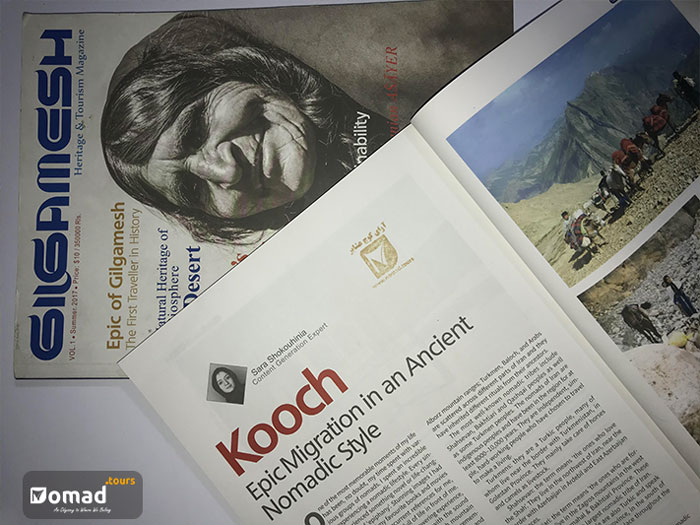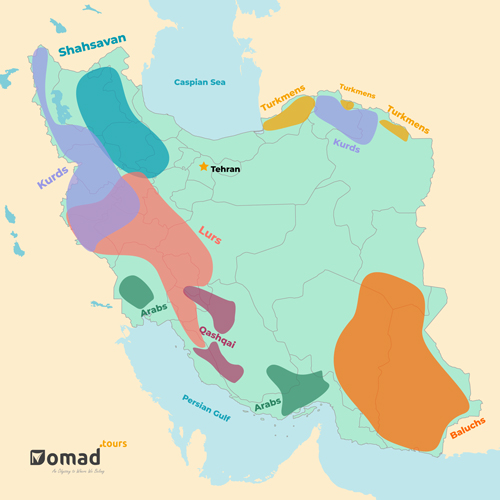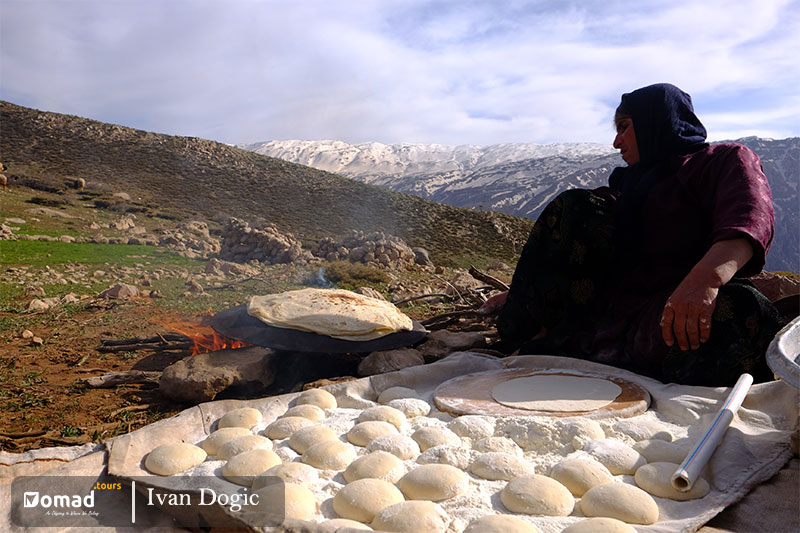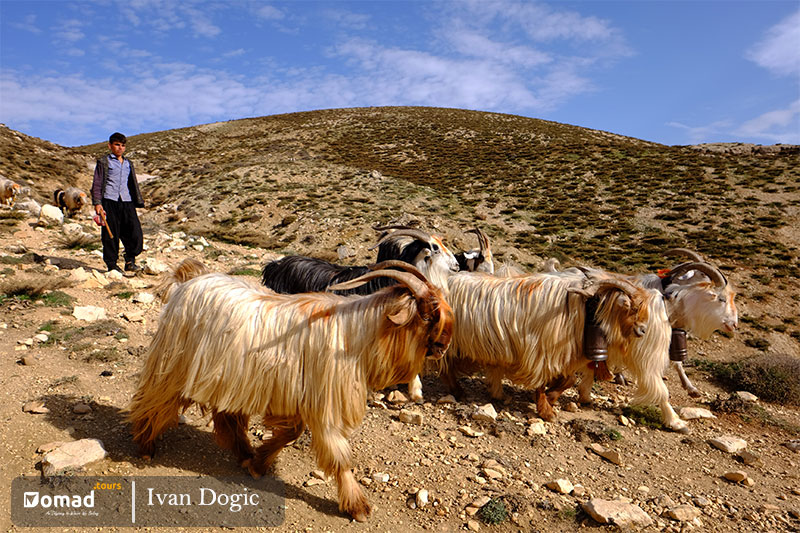
Kooch (Transhumance, kuch, Seasonal Migration) is the act of moving with livestock between summer and winter pastures (Yaylaq & Qishlaq) in search of grasslands for the livestock. Kooch (or Kuch or Koch) is the very epitome of a nomadic lifestyle. Because of ecological factors, each year one group of Iran nomads embarks on their seasonal migration on mountainous hinterlands of Zagros. Their kooch is a vertical one (vertical transhumance). In summer, they move to higher pastures where the weather is cooler, and in winter they come down to lower valleys. They usually go to the same pastures each year. The bigger families have their own pastures. Therefore, nobody else is allowed to camp in their pastures. The smaller ones join together to do kooch, for example, brothers or cousins do the kooch together. Sometimes, in families with small children or heavily pregnant women, only the nomad men and the livestock kooch, while the family move with cars.
Recently, the number of families who perform kooch in its traditional way has fallen drastically. On the one hand, some believe their nomadic lifestyle and not having a fixed habitation is tough, and on the other hand, they can’t stand not living as a nomad.
0. A Brief Summary
A nomad is defined as a member of a community without a fixed habitation. They regularly move between particular areas. There are three types of nomads around the world: hunter-gatherer nomads, pastoral nomads, and thinker/trader nomads.
Pastoral Nomads are one of the biggest populations of nomads around the world. They raise herds (sheep, cattle, goats, horses, and camels) and move with them to places with fresh, green pastures and suitable plants for their herd. They are sedentary in a specific location and move to another place to find resources.
There are different nomadic tribes in Iran including Bakhtiari, Qashqai, Shahsavans, etc. The population of nomads in Iran is around 1,000,000 people, which is 1.5% of Iran’s population. Of course, the nomadic population of Iran was more than a quarter of Iran’s population about 100 years ago.
The Bakhtiari tribe lives in the southwest of Iran. Their lifestyle has been preserved the most and as there are fewer roads made in their lands they have the biggest population of Iran’s nomads who still migrate on foot. Their territory, known as ‘Bakhtiari Land’, is located in an area between Isfahan and Khuzestan
Bakhtiari Nomads do their seasonal transhumance twice yearly in spring and autumn from mountains to fields and vice versa. Early in spring, they move from winter pastures to summer pastures, and in autumn they move back.
The distance between the two locations differs among different tribes, but it is about 300 km, which takes 10 to 15 days. For some tribes it is more than 400Km and they pass the whole Zagros range in 20-30 days with thousands of goats that move like a water flow in the mountains and they carry all their stuff with mules.
1. Definition
The word kooch comes from Turkish dialect, meaning ‘moving’, ‘moving of a group from a place to another’, ‘a group who moves in deserts’. In Lorish dialect, it refers to nomads’ seasonal transhumance between pastures with their livestock.
2. History
According to Encyclopǣdia Iranica, the traditional Bakhtiari way of life began in the Zagros highlands from the thirteenth century, “at first under the impact of the Mongol invasions, and probably attained its present form during the eighteenth century, in a defensive reaction against increasing fiscal and administrative pressures experienced under successive Iranian régimes.” Based on what the excavators found near Kermanshah and Khuzestan, it has been found out the age of kooch and basic models of farming goes back to more than 7000 BC. There are some hypotheses saying the earliest evidence of nomadism in Iran goes to Lur, Bakhtiari, and Qashqa’i nomads in prehistoric and Bronze Age of Iran.”
To know about the origin of kuch, we need to know about the origin of Bakhtiari people as they have performed it since centuries ago. But the history of these people and their tribes who are known as indigenous people of Iran has remained unknown. It is not clear when these people have come to the area, and what is their origin. Therefore, it is not clear since when these people have started doing kuch.
3. Iran Nomad Tribes
Iran has various kinds of tribes such as Lors, Kurds, Balooch, Arabs, Turks, and Guilaks. But the most well-known nomad tribes are Turkeman, Shahsevan, Bakhtiari and Qashqayi people. Nomads of Iran are the indigenous people of Iran who have their origin in about 8000 or 10000 years ago. They are independent, simple, hard-working people who have chosen to be on the move to make a living. They all settled in various parts of Iran, and they are from different ethnic backgrounds; some Turks are located in North West of Iran, others are habitants of Zagros and Alborz Mountain ranges; and, Turkman, Baluch, and Arabs, are all scattered in different parts of Iran and they have inherited different rituals from their ancestors. Some anthropologists believe Bakhtiari Nomads and the Lor are the first indigenous people of Iran. Therefore, the age of kooch needs to be investigated through the age of Bakhtiari people.

- Turkmens: from the Turk tribe living near the Turkmenistan border in Golestan Province. They mainly take care of horses and camels as their livestock.
- Shahsevan: the term means “the ones who love Shah (king)”. They live in the northwest of Iran, near the Azerbaijan border in Ardebil and East Azerbaijan Province.
- Bakhtiari: the term means “the ones who have the fortune with them”. They live in the Zagros Mountains in the west of Iran next to Isfahan Province in Chaharmahal & Bakhtiari Province. These nomads make up the largest nomadic tribe of Iran.
- Qashqayi: These people are also from the Turk tribe and speak Turkish. They live in Fars Province south of Iran. These people have now settled down in one pasture throughout the year.
4. Nomads through Time
There are estimated to be around 1.5 million nomadic pastoralists living in Iran today, although the figure is gradually decreasing. In the first two decades of the 20th century, the nomads were 50% of Iran population. In the 60s, the number decreased to 25%, and in 2017, it dropped to 1 or 2% of the country’s population—spread over some 35 million hectares in Iran. What makes Nomadism different from other lifestyles are: 1. dependence on livestock 2. Use of natural pastures 3. Kooch

Currently, Iran’s nomadic tribes are residing in 3 different approaches: Migrants, Semi-Migrants & Settled Tribes. Shahsevands are totally settled in villages. 90% of Turkmens and Qashqayi people are also settled in their tents or surrounding villages and they rarely migrate. But Bakhtiari people with the highest population are the ones who mostly do transhumance with their livestock. Iran Bakhtiari nomads never leave Mt. Zagros. Their summer pastures and winter pastures are in two different sides of Zagros, and they move on the ridges between these two destinations each year. In spring and summer, when the weather gets really hot, they often move to the northern and northwest of Zardeh, and in autumn and winter, when the northern parts are buried under heavy snow, they migrate to southern and southwest parts.
5. Kooch: The Epic Transhumance of Nomads
Nomadic transhumance or kooch is a technique of population movement which is done to accomplish a variety of goals. Changing of location in search of grasslands and moving in groups in ancient nomadic paths which are trodden by feet and hooves for thousands of years, are two outstanding characteristics of nomadic life. Kooch happens every year on a regular basis. Each tribe takes the same route each year, and they have their own pastures in which no other tribe can stay. They set up their tents in the same previous places called ‘Javargah’ which have been marked by stones. The nomads who have big flocks are the wealthy ones with more facilities who usually choose the longer routes while doing kooch. By contrast, those who are less fortunate choose the shorter routes and they usually postpone their migration.
Iran nomads also have their migratory routes, called IL-Rah, through which they pass in their seasonal transhumance. Their kooch vary in length and can reach 300 km. Nomads often migrate in large groups of at least “nomadic camps”. Sometimes they camp and stay in a pasture for a longer time when there is ample grass for the livestock. But soon, they have to move on before the next group of nomads arrives to prevent obstruction (Kalang) in pathways.
Kooch may take from one to six weeks. Since there are no facilities on nomads’ migration way, they carry everything they need up to two months. The timing is also of prime importance as the tribe must leave late enough for the ice to have melted to allow safe passage, but early enough to arrive in the green plains before they are overgrazed by other animals. There is a connection between performing kooch and climate changes. Sometimes kooch is brought to a temporary halt because of the harsh mountainous weather.
While doing kooch, sometimes the nomads have to pass near impassable path. The nomad men then have to stand in line in some narrow pathways to keep the livestock from falling. When they reach the rivers, women and children sit on the mules, but the livestock goes to the river while the nomad men guard them. Some other men also wait on the other side of the river to take the animals. Losing livestock is the inevitable part of each kooch. Sometimes the mules fall from the mountains. Therefore, nomads need to be quite alert all day along on the day of kooch. Here you can read Redzip Skomorac & Serial Hikers’ first-hand account of their kooch with Iran nomads.
5.1 Kinds of Kuch: Vertical & Horizontal
Nowadays, there are different methods of relocation exercised on a global scale amongst nomads. ‘Horizontal’ kuch occurs in dry, flat, vast deserts where water and grass can scarcely be found, like steppes in Saudi Arabia deserts or Kazakhstan Steppe.
There is also another type of relocation, called ‘Vertical’ kuch occurring in regions with a large difference in altitude where people move from low altitudes to higher ones in search of more favorable weather for their families and their animals, like in Iran. For instance, the vertical migration of Bakhtiari tribes happens when they move between north and south of Zagros mountain ranges.
In terms of scope, there are two types of nomadic migration, one is ‘long trans-regional route’ ascribable to the migration of Central Asian nomads, and the other is the ‘local migration’ attributed to the tribes such Qashqayi, Bakhtiari and, etc.
5.2 Five Reason Why Nomads Migrate?
Each year, Nomads move between summer pastures and winter pastures due to many reasons. The prominent reason for this lifestyle is to find grasslands for their animals. But, there are other reasons too:
- In hot and cold weather, there would not be enough food for the flocks. And since Nomads are highly dependent on nature, they need to follow its rhythm. Even if they do not have any flock, they follow the same pattern to avoid bitterly cold and scorching hot weather.
- Nomad men would have the opportunity to do farming in two different pastures.
- The fruits of oak trees are the next reason. In autumn, when the nomads move back to their winter pastures, the oak fruits are fully ripe. Nomads pick them up and make delicious bread from its flour. The bread would be used throughout the following winter.
- Last but not least, the tribe’s main economic activities are determined by the migration cycle. Nomads are accustomed to migration. Without it, they feel something is missing as if they have lost their main purpose in life. Each year, at the time of migration, they feel so thrilled at the prospect of their coming Kooch.
- It is also vital for the environment. Here you can read more.
6. Kooch under Bakhtiari Nomads’ Stewardship
6.1 Who are Bakhtiari Nomads?
Bakhtiari tribe or ‘the great Lor’ is one of the most important tribes of Iran. Their territory, known as ‘Bakhtiari Land’, is located in an area between Isfahan and Khuzestan. Zagros ranges pass through their land, diving it to two geographical regions; mountainous regions in the east, and flats in the west. The mountainous regions are Bakhtiaris’ summer pastures, and the plains and flats are their winter pastures. Nowadays, these people are the only nomad group who do transhumance.
They are estimated to be around 500000 people, living in an area of 7500 km. 40% of them (200000) are nomads and semi-nomads who move between summer and winter pastures. They are herdsmen with herds of sheep and goats.
They are of two main groups; ‘Haft-Lang’ and ‘Chahar-Lang’. Each has its own territory. The former migrate to eastern parts of Khuzestan, such as Andika, Masjed Soleiman, Shooshtar, Izeh, Shahrekord, and Brojen in Chahar-Mahal Bakhtiari. The latter moves mostly between Dezful and Izeh in Khuzestan, or Daran in Isfahan, and Aligodarz and Brojerd in Lorestan.
6.2. Bakhtiari’s Summer & Winter Pastures
Their summer pastures are in Isfahan’s western highlands. The highest mountain in the area is 4549 m. The winter pastures are in eastern parts of Zagros ranges, and it continues to some parts of Khuzestan province. Nomads use these pastures in their seasonal Kooch.
6.3. Bakhtiari Nomads’ Daily Share of Responsibilities
In Nomad family, everybody has her/his own shares of chores. Age and sex are two important factors in assigning the family members their tasks. So, men’s responsibilities are different from women, and children from grown-ups. But there are some works done by both men and women.
Chores done by women are: domestic chores; cooking, washing the dishes, milking, making dairy products, weaving Jajims, carpets, and black tent, fetching water from springs, taking care of the children while migrating. They sometimes do shepherding. In the time of kooch, women play an important role in gathering up the stuff and tent and loading the mules. Men also help them to pack on the day of migration.

Chores done by men: Men are responsible for economic and political tasks. Dealing with other tribes’ main members and Kalantars, commuting to cities and doing commerce. When the father is away, the older son does his responsibilities. Farming, renting lands, working in other nomads’ fields are some of their tasks.
Chores done by children: children have a leading role in shepherding and milking the flock. The main shepherd of the flock is always a man since it starts from 4 am to 6 pm. As the father of a nomad family has some other tasks to take care of, most of the time the sons do shepherding. Children also have their own small flocks of lambs. In Nomad families, children learn about their share of responsibilities from childhood. Boys do after their fathers, and girls follow their mothers.

7. Nomad Odyssey
According to ‘Longman Dictionary of Contemporary English’, odyssey has two meanings:
“[Literary] 1. A series of experiences that teach you something about yourself or about life. 2. A long journey with a lot of adventures or difficulties.”
Iran Nomads’ Transhumance is REALLY an odyssey both for the nomads and the travelers:
- It’s an odyssey for the nomads, because like what we see in the movies People of the Wind (1976, Anthony Howarth) and Grass. A nation’s battle for live (192, Merian C. Cooper Ernest B. Schoedsack) during the migration the nomads face with so many ups and downs and every time they need to come up with a solution to overcome the hardships and pass the impassable mountains. Every year, they await the spring to undertake the journey once again, and when they are done with the migration, they feel quite pleased with the odyssey they have accomplished.
- It’s an odyssey for us/travelers who join the nomads too, because throughout the days, we are with the nomads moving in Zagros hinterlands, we are going to gain some precious first-hand experiences.
- The most important one is the experience of casting doubt on ‘ourselves’. We will question our life, whether we are on a right path. Nomads make us think about the goals we have set for ourselves. ‘What if I’m not right?’ ‘What if I need to make some changes in my life’…
- We experience peace and tranquility far away from the worldly concerns we normally have in our lives. There, behind the magnificent mountains, it is just we and the sky and the whole pasture in front of us. All we hear is the sound of the animals & the gentle breeze.
- Like the nomads, we are going to experience some adventurous days in Zagros mountainous areas. The adventure of living with the indigenous people in Iran’s pristine nature, the adventure of trekking in the merciless Zagros ranges, experiencing the wildlife, etc.
